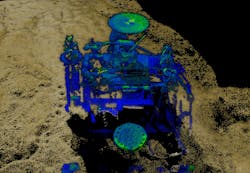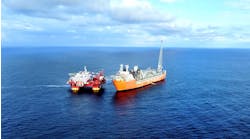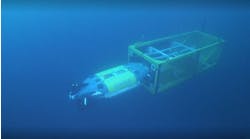Offshore staff
FORT WILLIAM, UK – In December 2016, DOF Subsea demonstrated a dynamic underwater laser scanning system at The Underwater Centre in Fort William, Scotland, as a replacement for traditional metrology techniques.
The system integrates 2G Robotics’ underwater laser scanner, the ULS-500 PRO, with Sonardyne’s inertial navigation sensor, SPRINT, Syrinx DVL, and 6G acoustics.
Seatronics provided sensors and project/technician support.
Traditionally, metrology campaigns using long baseline (LBL) acoustics and photogrammetry have taken up substantial vessel and ROV time. In addition, LBL requires physical interaction with thesubsea facilities, while photogrammetry – according to 2G Robotics – is unable to provide real-time results.
The demonstration was therefore designed to quantify the reduction in operational time achievable and the increased accuracy of dynamic laser scanning for subsea metrology.
Two structures, each containing four flanges, were placed on the seafloor with an approximate baseline distance of 18 m (59 ft). Control measurement for the analysis was established by an LBL acoustic technique, with flange orientations provided by gyro frames.
A Triton XL ROV was equipped with the 2G Robotics/Sonardyne survey system. The ULS-500 PRO was mounted at an angle of 30° to capture the side facing hubs, upward facing hubs, and seabed in a single scan pass over the 18-m baseline.
Each scan run took around four minutes to complete, with the ROV performing multiple redundant runs from structure-to-structure at an altitude of around 3 m (9.8 ft).
Data was transmitted to the surface in real-time, processed initially through EIVA navigational software and then through DOF’s Metro Prep software for automated metrology analysis.
From these high-resolution point clouds, measurements were taken to facilitate fabrication of spools and jumpers, at the same time providing as-built condition assessments.
The measurements of the vertical jumper metrology and the horizontal spool metrology were within accepted industry tolerances, 2G added.
The main results are said to have included:
- Reduced survey time - Significant reduction in the time to gather the data when compared to other techniques.
- Real-time data - Delivery of final metrology measurements offshore within hours of data acquisition.
- Contactless - No physical interaction with assets is required.
- Flexible deployment - Configurable mounting orientations on ROVs for specific survey applications.
03/22/2017



